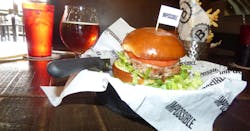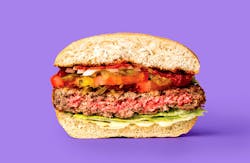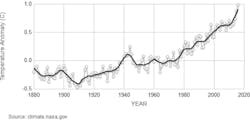Where's the Beef? Plant-Based Burger a Big Win for Manufacturing
It's an unsettling feeling going into one of Cleveland's most popular burger joints, B Spot, run by celebrity chef Michael Symon, (a guy who wrote a cookbook called Carnivore), with the intention of eating a burger comprised solely of plant-based materials.
People make compromises for work all the time, and I had a story to write. I read about some Silicon Valley startup called Impossible Foods that alleges it's absolutely possible to make a delicious, fatty, blood-dripping burger, a bona fide bovine stand-in that's exponentially more sustainable to manufacture. They call it the Impossible Burger, a daring name for a veggie burger in a country that the USDA says consumed 25 BILLION pounds of beef in 2016.
And aside from curiosity, that's the reason I thought we should taste-test it. Our mission is to seek out all the most innovative and efficient equipment and methodologies to improve American plants and factories.
Impossible Foods says that the high tech processing of their grown-in-the-ground beef, derived chiefly from coconut oil, potato, wheat, and soy, requires "about 75% less water, generates about 87% fewer greenhouse gases, and requires around 95% less land than conventional ground beef from cows." If true, we dare say that's impossibly efficient.
You'd be ecstatic if we told you about a storage unit that could save your factory 5% floor space.
Earth is essentially one giant food factory, and 30% of the planet's ice-free land is used to grow the food, from grains to veggies, for our food (chicken, pigs, and cattle). If this burger comes close enough to satisfy the general public, that frees up vast swaths of land to grow sustenance for the 11% of the world's population (795 million) that doesn't get enough food for normal activity. And fewer cattle means fewer greenhouse emissions. The methane they emit is 30 times more harmful to the atmosphere than CO2.
But it's a fool's errand to appeal to a person's heart or mind when you can go straight to the stomach.
Obviously, it already has one carnivorous convert, as Symon decided to put it on B Spot's menu.
“In 10 years of eating non-meat burgers I’ve never experienced anything like this," Symon told a local news outlet. “This is a total game-changer.”
Two things to note about the NED staff: We love game-changers, and we love expensing meals.
Also, I wanted to throw a meatless bone to our editor and hopeless herbivore, Travis Hessman. I gently rib him all the time about his protein-deficient proclivities, and sometimes not so gently, like when I inadvertently suggested a lunch meeting at Symon's exquisite Mabel's BBQ. Our guest and I loved every bite, while he settled for a limp bucket of green beans. This would be a make-good for that.
I also genuinely wanted his opinion for once. There are about 7.3 million vegetarians in America, and while Impossible Foods constructed this patty's consistency and taste to appeal to meat-lovers, vegetarians, and even vegans, could partake.
We also brought along Laura Davis, our product writer, for a third opinion.
When our server arrived, I thought he may scoff at us for going green, because I know I would. Instead, he just jotted down the order and asked what temperature we wanted, just like you'd expect when ordering a "real" burger.
When it came out about 10 minutes later, if I hadn’t known what it was made of, I would have assumed it was beef. The outside of the medium-cooked burger was seared to a dark brown, and it had a lustrous, greasy sheen, too.
After a quick bifurcation, I discovered the pinkish interior also appeared nearly beef-like, Ground beef has that wormy texture from being pressed through a grinder; this seemed more clumped together. And the reddish juice seeping from its pores was ersatz blood, I suppose.
Biting down, my mouth did not fall into some uncanny valley of flavor, where it's close but not enough to the real thing to embrace. It wasn't the original, that's for sure, but it was actually pleasantly surprised how close it was, like hearing Billy Joel live nowadays.
How the heck did they do this?
Mission Possible
Impossible Foods says the secret is heme, the iron-containing molecule that carries oxygen throughout the body, and is also found in plants.
"The craving for meat is really the craving for heme," IF founder and CEO Pat Brown says.
The scientists at Impossible Foods synthesized soy DNA and inserted it into yeast cultures to grow the heme in the lab.
Here's a video explanation:
To get the right formula, it took years of tinkering, along with process equipment including mass spectrometers and gas chromatograms to understand the flavor of beef.
They have patented the process which creates the different texture and flavor profiles, and are always working on getting the right taste and tensile strength to reproduce chicken, lamb, pork, and theoretically, even whale (which is quite rubbery).
It didn’t always go well.
"Through the years we have made some untasty experimental samples, some untasty to all, other samples depending on the person you ask," says Celeste Holz-Schietinger, Principal Scientist at Impossible Foods. "An example was Impossible taco meat made with very high levels of heme; it was so livery. Some people liked it but I couldn't stand the taste."
The burger taste, though, they can count as a success. I would certainly eat another, as it tasted similar enough to other burgers and has zero cholesterol, which I should probably cut down on. It was about even with a quarter-pound beef patty in terms of calories and protein, though the sodium level (from all the preservatives) is off the charts.
Laura was fairly ambivalent, neither loving nor disliking it. She would not try another.
The real surprise was Travis, who had this to say:
The taste was remarkable, honestly. I’ve been a vegetarian for my entire adult life, which means I haven’t had a burger actually prepared by a chef in a little over 20 years.
While the quality of frozen veggie patties has improved dramatically over that time, their overall flavor remains static and mild. I rely on condiments to give it any real taste.
Having a real, chef-prepared burger, though, reminded me why I ever liked burgers in the first place, and why friends and coworkers always buy them in otherwise nice restaurants. It was delicious—it was an original, fresh, and altogether amazing meal.
His one gripe was on the texture, which he called "extremely airy."
Scaling Up
The cattle industry is in as much danger from this faux fauna as plastic injection molding is from 3D printing. That's not to say Impossible Foods, and competitor Beyond Burger, don’t have a niche to fill. They both come in frozen patties, with the latter already available in grocery stores.
Impossible Foods doesn’t seem far behind.
"Our mission is to transform the global food system," Brown says. "It's a huge opportunity, so we're embarking on one of the largest scale-ups in the history of the food industry,"
To that end, they have scaled from about 300,000 lb./month to now around a 1 million lb./month in their Oakland facility.
Chris Gregg, VP of the supply chain, says the process is similar to dairy and frozen dinner prep on the upstream and conventional burger-making on the backend. The heme made from yeast combines with the fat emulsion, and vegetable and protein mixture, and hydrated.
Even though e.coli isn’t a risk here, they play it safe and operate under beef guidelines, with an 8-hour sanitizing period and extensive swabbing program.
"Should this be overkill for now, that's OK with us," Gregg says. It is safe to eat raw. I actually like the taste, which is a little salty, just like beef."
In September, just over 50 restaurants served the Impossible Burger; now there are more than 250. The biggest challenge now is to match beef's price point, which Gregg is confident they can do as they get more familiar with the process and can excise any inefficiencies. The emulsion, for example, may be cheaper to make offsite.
And current manufacturing tech may hasten that process.
"Being able to do something like this today is more an opportunity than it ever has because of AI and automation and the ability to quickly measure performance and iterate based on that," Gregg says.
While no amount of yeast and genome sequencing will probably ever recreate a perfectly cooked medium-rare filet mignon, Impossible Foods has proved that a suitable stand-in for ground beef is achievable. And what it represents makes the breakthrough all the more exciting.
Remember, if you will, the early hybrids of yester-millennium—1997 to be exact. Toyota released the first hybrid, the Prius, on a small scale. Sure, the Captain Planets among us jumped at the chance to drive one to save the Earth, even though aesthetically they were a bit lacking, and in terms of power, 80 hp is impressive only to a Vespa owner.
Now Tesla's totally electric new Roadster looks amazing and accelerates from 0 to 60 mph in 1.9 seconds. Even the most devout gearhead would take it out for a test drive. That's 20 years of progress.
If Impossible Foods keeps improving, it could transform the landscape of food manufacturing, and vastly purify the atmosphere. That's a shame here in Cleveland, as global warming sounds like a dream come true. The 40% of the world's population who live by oceans might disagree, I suppose.
One thing we can all agree on is that we should probably be using agricultural land for human food, and not our food's food.
And that's the area Impossible Foods has the supreme advantage: rapid evolution.
"We're getting better every day," Brown says. "The cow is not."
About the Author
John Hitch
Editor, Fleet Maintenance
John Hitch, based out of Cleveland, Ohio, is the editor of Fleet Maintenance, a B2B magazine that addresses the service needs for all commercial vehicle makes and models (Classes 1-8), ranging from shop management strategies to the latest tools to enhance uptime.
He previously wrote about equipment and fleet operations and management for FleetOwner, and prior to that, manufacturing and advanced technology for IndustryWeek and New Equipment Digest. He is an award-winning journalist and former sonar technician aboard a nuclear-powered submarine where he served honorably aboard the fast-attack submarine USS Oklahoma City (SSN-723).





